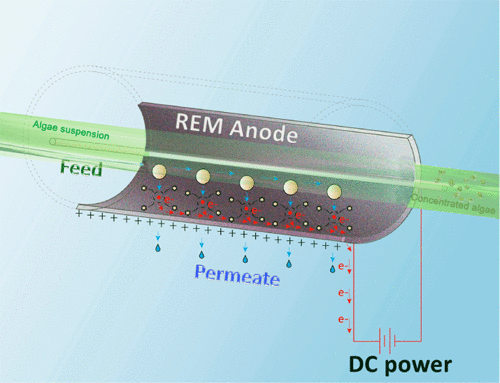当前位置:
X-MOL 学术
›
Environ. Sci. Technol.
›
论文详情
Our official English website, www.x-mol.net, welcomes your feedback! (Note: you will need to create a separate account there.)
Microalgae Filtration Using an Electrochemically Reactive Ceramic Membrane: Filtration Performances, Fouling Kinetics, and Foulant Layer Characteristics.
Environmental Science & Technology ( IF 11.4 ) Pub Date : 2020-01-09 , DOI: 10.1021/acs.est.9b07022 Likun Hua 1 , Han Cao 1 , Qingquan Ma 1 , Xiaonan Shi 1 , Xuezhi Zhang 2 , Wen Zhang 1
Environmental Science & Technology ( IF 11.4 ) Pub Date : 2020-01-09 , DOI: 10.1021/acs.est.9b07022 Likun Hua 1 , Han Cao 1 , Qingquan Ma 1 , Xiaonan Shi 1 , Xuezhi Zhang 2 , Wen Zhang 1
Affiliation

|
Electrochemical membrane filtration has proven to be successful for microbial removal and separation from water. In addition, membrane fouling could be mitigated by electrochemical reactions and electrostatic repulsion on a reactive membrane surface. This study assessed the filtration performances and fouling characteristics of electrochemically reactive ceramic membranes (a Magneli phase suboxide of TiO2) when filtering algal suspension under different dc currents to achieve anodic or cathodic polarization. The critical flux results indicate that when applying positive or negative dc currents (e.g., 1.25-2.5 mA·cm-2) to the membrane, both significantly mitigated membrane fouling and thus maintained higher critical fluxes (up to 14.6 × 10-5·m3·m-2·s-1 or 526 LMH) compared to the critical flux without dc currents. Moreover, applying dc currents also enhanced membrane defouling processes and recovered high permeate flux better than hydraulic and chemical backwash methods. Moreover, fouling kinetics and the cake layer formation were further analyzed with a resistance-in-series model that revealed many important but underexamined parameters (e.g., cake layer resistance and cake layer thickness). The cake layer structures (e.g., compressibility) were shown to vary with the electrochemical activity, which provide new insight into the biofouling mechanisms. Finally, the algogenic odor, geosmin, was shown to be effectively removed by this reactive membrane under positive dc currents (2.5 mA·cm-2), which highlights the multifunctional capabilities of electrochemically reactive membrane filtration in biomass separation, fouling prevention, and pollutant degradation.
中文翻译:

使用电化学反应陶瓷膜的微藻过滤:过滤性能,结垢动力学和污垢层特性。
电化学膜过滤已被证明可成功地去除水中的微生物并从水中分离。另外,可以通过电化学反应和反应性膜表面上的静电排斥来减轻膜污染。这项研究评估了在不同的直流电流下过滤藻类悬浮液以实现阳极或阴极极化时,电化学反应性陶瓷膜(TiO2的Magneli相低价氧化物)的过滤性能和结垢特性。临界通量结果表明,在膜上施加正或负直流电流(例如1.25-2.5 mA·cm-2)时,都可以显着减轻膜污染,从而保持较高的临界通量(高达14.6×10-5·m3) ·m-2·s-1或526 LMH)与没有直流电流的临界通量相比。此外,与液压和化学反冲洗方法相比,施加直流电流还增强了膜的除垢过程,并能更好地回收高渗透通量。此外,用串联电阻模型进一步分析结垢动力学和滤饼层的形成,该模型揭示了许多重要但未经仔细检查的参数(例如,滤饼层的电阻和滤饼层的厚度)。饼层结构(例如,可压缩性)显示出随电化学活性而变化,这为生物污染机理提供了新的见识。最后,在正向直流电(2.5 mA·cm-2)下,该反应膜可有效去除藻土臭味,这突显了电化学反应膜过滤在生物质分离,防止结垢和污染中的多功能功能。降解。
更新日期:2020-01-22
中文翻译:

使用电化学反应陶瓷膜的微藻过滤:过滤性能,结垢动力学和污垢层特性。
电化学膜过滤已被证明可成功地去除水中的微生物并从水中分离。另外,可以通过电化学反应和反应性膜表面上的静电排斥来减轻膜污染。这项研究评估了在不同的直流电流下过滤藻类悬浮液以实现阳极或阴极极化时,电化学反应性陶瓷膜(TiO2的Magneli相低价氧化物)的过滤性能和结垢特性。临界通量结果表明,在膜上施加正或负直流电流(例如1.25-2.5 mA·cm-2)时,都可以显着减轻膜污染,从而保持较高的临界通量(高达14.6×10-5·m3) ·m-2·s-1或526 LMH)与没有直流电流的临界通量相比。此外,与液压和化学反冲洗方法相比,施加直流电流还增强了膜的除垢过程,并能更好地回收高渗透通量。此外,用串联电阻模型进一步分析结垢动力学和滤饼层的形成,该模型揭示了许多重要但未经仔细检查的参数(例如,滤饼层的电阻和滤饼层的厚度)。饼层结构(例如,可压缩性)显示出随电化学活性而变化,这为生物污染机理提供了新的见识。最后,在正向直流电(2.5 mA·cm-2)下,该反应膜可有效去除藻土臭味,这突显了电化学反应膜过滤在生物质分离,防止结垢和污染中的多功能功能。降解。



























 京公网安备 11010802027423号
京公网安备 11010802027423号